Supercapacitor & Lithium battery

전기차
최근 급성장하는 전기차에는 높은 에너지 밀도와 장시간 사용이 가능한 에너지 저장소자가 필수적이다. 이를 위해 많은 연구가 되고 있는 부분은 리튬이온전지와 수퍼커패시터이다. 리튬전지는 리튬이온의 전기화학 반응을 통해 전극 물질의 화학 에너지를 전기 에너지로 변환시키는 소자이며, 수퍼커패시터는 이온의 물리적 흡착에 의해 전기 에너지를 저장하는 소자의 차이점이 있다. 리튬전지는 수퍼커패시터와 비교하여 에너지 밀도가 높고, 수퍼커패시터는 리튬이온전지 보다 순간적인 출력이 가능한 장점이 있다.
A fast-growing electric vehicle requires a high energy density and long-term energy storage. Lithium-ion batteries and supercapacitors are energy sources for this. Lithium batteries are devices that convert chemical energy into electrical energy, while supercapacitors store electrical energy by physically adsorbing ions. Lithium batteries have high energy density and supercapacitors have high output.
전지에서 가장 중요한 요소는 ‘전극’이다. 전극재료로는 화학적 안정성 및 전기전도성이 뛰어난 탄소 재료가 많이 사용된다. 특히, 빠른 충방전을 위해서는 전극으로의 전해질 이온의 확산이 빠른 다공성 구조(porous structure)가 필요하고, 긴 시간 사용을 위해서는 표면적이 큰 전극재료가 필요하다. 이와 같은 특성을 구현하기 위하여 다공성 구조의 탄소재료가 활용된다. 기공은 그 크기에 따라 마이크로, 메조, 매크로 기공으로 분류된다. 마이크로 기공이 많을 수록 넓은 표면적을 가지며 화학반응이 더 많이 진행된다. 메조, 매크로 기공은 전기화학반응에 참여하는 이온의 이동을 향상시킨다. 즉, 우수한 특성의 전지를 제작하기 위해서는 다양한 크기의 기공을 디자인하는 것이 중요하다.
The most important element in the cell is the electrode. Carbon is widely used as an electrode material. In particular, porous carbon is utilized for fast charge / discharge and high energy density. Pores are classified into micro, meso, and macropores according to their size. The more micropores, the larger the surface area and the more the chemical reaction proceeds. Meso, macropores enhance the migration of ions involved in electrochemical reactions. In order to realize a battery of excellent characteristics, it is important to design pores of various sizes.
우리는 다양한 방법으로 다양한 크기의 다공성 탄소전극을 제작하는 기술을 연구한다. 자기조립(self-assembly)에 의해 나노탄소 입자를 제작하거나, 또는 리소그래피 기술을 이용하여 다공성 탄소를 제작하기도 한다. 특히, 본 연구진은 3차원 리소그래피 (3D interference lithography) 기술을 통해 탄소전극을 제작하는데 독자적인 기술을 보유하고 있다. 또한, 우리는 합성한 다공성 전극에서의 전기화학 반응을 분석한다. 구체적으로는 다공성 전극내에서 이온의 확산 및 이동현상, 그리고 이온의 흡착에 대해 연구한다. 궁극적으로 우수한 특성의 전극재료 개발을 목표로 한다.
We fabricate porous carbon electrodes of various sizes in a variety of ways. The nanocarbon particles are prepared by self-assembly, or the porous carbon is produced by lithography. In particular, we have a unique technology for fabricating carbon electrodes using the 3D interference lithography technique. We also analyze electrochemical reactions in synthesized porous electrodes. Specifically, the diffusion and migration of ions in the porous electrode and the adsorption of ions are studied. Ultimately, we aim to develop porous carbon materials with excellent properties.
<관련 대표 논문>
Cheolho Kim; Da-Young Kang; Jun Hyuk Moon*. Full lithographic fabrication of boron-doped 3D porous carbon patterns for high volumetric energy density microsupercapacitors. Nano Energy, 53 (2018) 182–188. (IF : 13.120, JCR 상위 4.79%) 
Donghee Gueon; Jeong Tae Hwang; Seung Bo Yang; Eunkyung Cho; Kwonnam Sohn; Doo-Kyung Yang; Jun Hyuk Moon*. Spherical Macroporous Carbon Nanotube Particles with Ultrahigh Sulfur Loading for Lithium-Sulfur Battery Cathodes. ACS Nano, 2018, 121, 226-233. (IF : 13.709, JCR 상위 4.21%) 
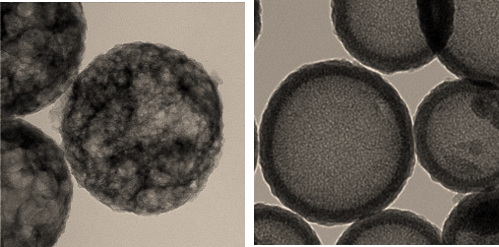
다공성 탄소입자
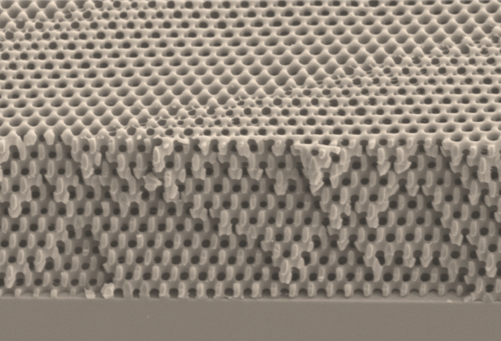
3차원 탄소 패턴
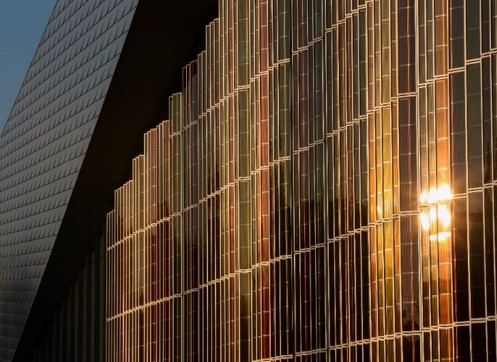
건불부착 태양전지
차세대 태양전지는 기존의 발전용을 넘어서, 건물 유리창 등에 부착할 수 있는 형태로 개발이 되고 있다. 특히, building integrated solar cell (건물부착형 태양전지)는 투명하면서도 높은 효율의 태양전지가 필수적이다. 특히, 이와 같은 고효율의 태양빛 전환을 위해서는 빛을 흡수하여 광전기화학반응을 일으키는 전극(photoelectrode)이 중요하다.
Next-generation solar cells are being developed in such a form that they can be attached to buildings, such as building windows, beyond conventional power generation. In particular, building integrated solar cells require transparent and highly efficient solar cells. Especially, for such high efficiency solar light conversion, it is important to control photoelectrode which absorbs light to cause photoelectrochemical reaction.
우리 연구실에서는 나노입자를 이용하여, 광학적 나노구조의 전극소재를 개발하고 있다. 구체적으로는 구형이며 일정한 크기의 나노입자를 자기조립하고, 이것을 틀로 이용하여 3차원의 전극을 개발한다. 이와 같은 전극은 빛의 산란을 극대화하여, 높은 빛흡수효율을 갖고, 그에 따라 높은 전하생성밀도를 갖는다. 동시에 패턴화된 구조에 의해 방향성 있는 확산을 유도할 수 있어, 생성된 전하의 활용을 극대화 할 수 있다.
한편, 태양전지를 이용하여 수소 연료의 생산도 가능하다. 우리 연구실에서는 태양 빛을 이용하여 물을 분해하여 수소를 얻는 광화학반응도 연구하고 있다. 앞서의 태양전지는 생성된 전하가 전기적 일(electrical work)을 하는 반면에 물분해의 경우에는 전하가 화학반응을 일으킨다는 차이점이 있다.
우리 연구실에서는 앞서의 나노입자로 제작된 3차원 전극을 이용하며, 특히 화학반응을 증대하기 위하여 이온 및 생성물의 확산이 용이하도록 다공성 구조를 제어하는 연구를 진행하고 있다.
In our laboratory, we use three-dimensional electrodes made of the above nanoparticles, and in particular, we are conducting research to control the porous structure so as to facilitate the diffusion of ions and products in order to increase the chemical reaction.
<관련 대표 논문>
Kiwon Kim; Seong Kyung Nam; Jong Hyeok Park; Jun Hyuk Moon*. Growth of BiVO4 nanoparticles on a WO3 porous scaffold: improved water-splitting by high band-edge light harvesting. J. Mater. Chem. A(selected as journal cover), 2019, 7, 4480–4485. (IF : 9.931, JCR 상위 6.19%) 
Dong Ho Choi; Seong Kyung Nam; Kinam Jung; Jun Hyuk Moon*. 2D Photonic Crystal Nanodisk Array as Electron Transport Layer for Highly Efficient Perovskite Solar Cells. Nano Energy, 56 (2019) 365-372. (IF : 13.120, JCR 상위 4.79%) 
Dong Ho Choi †; Seong Kyung Nam †; Kiwon Kim; Jun Hyuk Moon*. Enhanced photoelectrochemical water splitting of bismuth vanadate by photon upconversion luminescent reflector. Angew. Chem. Int. Ed. 2019, 58, 21, 6891-6895. (†Co-first author, IF : 12.102, JCR 상위 8.19%) 
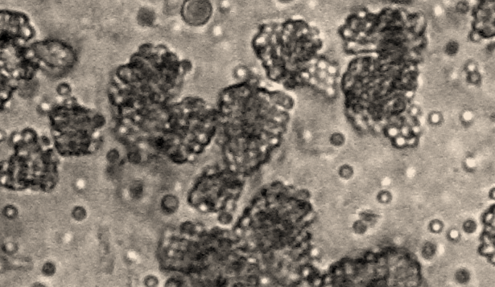
나노입자 자기조립
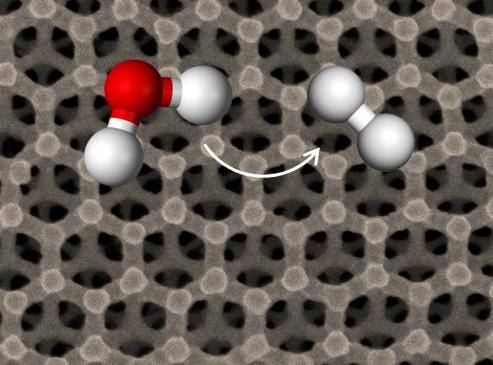
광전기 화학 다공성 전극
메탄은 열역학적으로 매우 안정한 물질로 반응을 일으키기 어려운 물질이다. 기존의 메탄 개질 반응은 고온 및 고압 조건의 촉매반응으로만 가능하였다.
Methane is a thermodynamically very stable material that is difficult to react. Existing methane reforming reaction was possible only by catalytic reaction under high temperature and high pressure conditions.
우리 연구실은 최근 상온/상압에서 메탄을 전환하는 획기적인 연구를 시작하였다. 우리 연구실은 복합 촉매소재를 이용하여, 메탄을 알코올로 산화하는 연구를 수행하고 있다.
Our laboratory has started a groundbreaking study to convert methane at low temperatures. Our laboratory conducts a study of partial oxidation of methane using a composite catalyst material.
<관련 대표 논문>
In preparation


